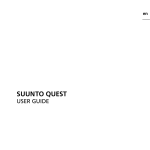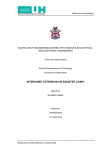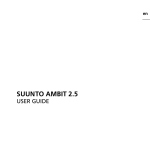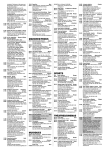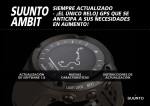Download FAQ Ambit
Transcript
AMBIT FAQ GENERAL INFORMATION Q: Do I need a computer to take Ambit into use? A: You need to wake up the unit by charging it. You can do this by either attaching the unit with the USB-cable to PC or by charging the unit with USBcompatible wall charger. The USB-cable comes in the device package whereas the charger is available as separate accessory. Q: Is Ambit compatible with Macs? A: Yes, you can attach the device to any USB compatible PC or Mac for charging. Moveslink software that you need for connecting your Ambit to Movescount.com online service is both PC and Mac compatible. Q: How do I turn on the unit? A: You can turn on the unit by pressing any. Commercial products will wake up by charging them either with the USB-cable or USB-compatible Suunto AC charger. Q: Can I swim with my Ambit? Can the Ambit be used for diving? A: Yes, Ambit is water resistant up to 100 meters. However, heart rate reception is not possible while swimming because the ANT signal doesn’t propagate in water. There are no diving functions in Ambit. Q: How can I see my previous exercise? A: You can find previous exercise log from the device. For full exercise history you can go to Movescount.com. In order to transfer your exercise logs to Movescount, you need to connect to Movescount by using the Moveslink application. Q: Will there be a SW-update still during 2012 for Ambit? If yes, when shall I know more about the new features? Can I propose new features that I think should be included in the next SW-release? A: Yes there will be at least one new SW-release for Ambit in the Fall of 2012. Suunto will publish a list of features around summer time 2012. You can send us feedback and ideas for new needed features through email. The email address is [email protected]. Q: What is a 3D compass? A: 3D compass is a compass unique to Suunto that will show accurate readings also when the compass is tilted. Hence, you don’t need to keep the compass on level to get steady readings. Q: Are the 2 straps of Ambit compatible with both Ambit Black and Ambit Silver? A: Yes. Q: What does it mean that each version of Ambit has both light and dark displays? A: You can invert the display colour in both Ambit versions (Silver and Black) from light to dark or vice versa simply by long pressing the VIEW button. Q: Do I get all the physiological parameters and analysis that Suunto t6 has also with Ambit? A: Yes, beat to beat HR data is available from Ambit and respective HR analysis can be done in Movescount.com just like with t6. Q: When I leave the Ambit e.g. on a table for a while the screen gets blank, why? A: This is a power saving mode of Ambit that activates automatically if the device is still for 30 minutes. It deactivates also automatically when you move the device again. Q: Is it possible to set a waypoint live on the wrist unit? A: Yes, you can set a waypoint of the location in which you currently are. The possibility to set a waypoint to another location is possibly added in the second sw release in October 2012. Q: Is Ambit compatible with Google Earth 3D and digital maps? A: Tracks made by Ambit can be exported from Movescount in KML/GPX format, which in turn can be imported to Google Earth or any other digital map software (that support kml/gpx format) . This functionality will be available on spring 2012. Direct integration to e.g. Google Earth (by pressing a button) will not be available in the foreseeable future. Q: Is it possible to create routes with several waypoints in Ambit? A: No, not in the foreseeable future. Q: Is it possible to name a waypoint in Movescount and wrist unit? A: In the wrist unit you can select an icon and a generic name (e.g. hill, mountain, river, etc…) but not name the waypoint with freely selected letters. In Movescount you can name the waypoint with freely selected letters, as well as modify the existing name of a waypoint created in Ambit. Q: Will the sw version 2.0 in October 2012 have ANT+ compatibility and is there going to be power presented in Ambit? A: Full ANT+ compatibility is not in rel 2.0 but possibly the 2.0 supports selected power meters. Q: How long log can I store in my Ambit? A: The maximum length of a log in Ambit is 16 hours. This means that you are logging GPS, HR, altitude, air pressure and other relevant data with 1 seconds interval. Please note that is autolaps are on and the interval is short then the length of the log is shorter than the 16 hours. If the recording interval is longer (for GPS data it can be 60 seconds and for other data it can be 10 seconds) the length of the log is also longer. Q: Does my Ambit work with the Russian GPS system GLONASS? A: No, Ambit is not compatible with GLONASS. HEART RATE Q: Does Ambit come with Heart Rate belt? A: You can buy Ambit with or without HR belt. Q: If I buy the Ambit without HR-belt, can I upgrade my Ambit into full functionality simply by buying the HR-belt – without needing to pay any extra beyond the price of the belt and without upgrading the SW? A: Yes, the full functionality is there in each Ambit and you can enjoy the HRfeatures (such as calories, real-time HR, average HR, peakTE etc.) simply by buying the HR-belt and pairing it with your Ambit. Q: Which HR belts does my Ambit work with? A: The Suunto Ambit has been designed to work with the new Suunto ANT belt which differs significantly from the Dual Belt. While the Ambit can receive a signal from the Dual Belt we do not recommend using it with the Ambit as doing so may result in incorrect heart rate, consumed calories, Peak Training Effect or recovery time. Q: How many HR belts can be paired with Ambit? A: 1 at a time. BATTERY & CHARGING Q: How can I charge the device? A: You can charge the unit with USB-cable from your computer’s USB port or by plugging the cable to an AC charger. The USB cable is part of the Ambit sales package whereas the AC charger is available as a separate accessory. Q: Is the USB-cable that comes with Ambit the same as the X10 charging cable? A: No, the X10 includes electronics that are not included in the Ambit USBcable. That’s why X10’s USB cable should not be used to charge Ambit. Q: Why doesn’t Suunto include an AC charger in the Ambit package? A: Ambit is very much linked with the online service (Movescount) where you do most of the device settings and upload and analyze your activities. So the assumption is that you will be plugging the device to your PC regularly and the device is charged from the PC simultaneously. Of course we want to provide our customers also the possibility to use wall charger if they so choose. Q: How long does the battery last? A: The duration of the battery depends on how the device is used. If the device is taking GPS fix each second then battery lasts at least 15 hours whereas if the device is taking GPS fix once every 60 seconds the battery duration is 50 hours. If you use only the altimeter, barometer, compass and time functions then the battery lasts 30 days. Q: How long does it take to charge the unit? A: It takes approximately 2 hours to charge an empty battery. NOTE: If the power supply you are using gives lower voltage or current than the 5V/500mA according to USB standard then the charging time may be longer. Q: Does the Ambit's battery last longer if I use Bike POD? A: Yes, if you don't use the integrated GPS then the battery will last longer. GPS Q: How long does it take to get a GPS fix with the unit? A: The first time you take a GPS fix with the unit it may take several minutes but in later use the device should get the fix in less than 60 seconds, in optimal conditions even in a few seconds. Q: How do I know the device has got the GPS fix? A: The device gives an indication sound and a pop us screen with text “GPS found” appears on the screen. Q: What does the %-number tell me in the GPS search mode on the Ambit screen when I am waiting for the GPS-fix? Why does the %-number go downwards/start from lower value again? A: The GPS search indicator shows a %-number, which can be interpreted the following way: 0% - GPS receiver is broken. 5% - GPS receiver OK, searching for satellites. 10% - 5 satellites visible, data transfer from the satellites starts. (Note: This might go back to 5% state if signal quality from satellites is poor.) 50% - data received from 5 satellites. 81% - data received for 30s from those 5 satellites with high signal strength. 100% - GPS fix is ok (position accuracy may still be poor) (Note: If signal strength drops the %-number goes back to 10%.) If the %-indicator value drops or stays the same for longer time, improve your position and make sure that the Ambit nose has an open view towards the sky. Do not start moving while waiting for the fix, as this delays the completion of the fix. Ambit should get a fix within 60 seconds in all situations under open sky. Q: Can the altitude be measured with GPS? A: Not in the 1st software release in March 2012 but possibly in the second software release in October 2012. Q: How many channels does Ambit’s GPS use? A: 24 channels, which is the maximum amount of satellites in the GPS system. Q: It seems like my product is losing GPS signal very easily. What can I do? A: If the product is losing gps signal too easily you should stop moving and keep it under clear sky for 12 min to receive all needed gps data from the satellites. You should keep the antenna (located in the “nose” of the product) up and product stable during this data collection. CUSTOMIZED SPORT MODES Q: How many sport modes can I have in my device at a time? A: You can have up to 10 sport modes in your device simultaneously. Q: How many pieces of information can I have in each custom mode? A: You can include 1-8 displays in each sport mode. One display can have 1-3 pieces of data depending on the type of data. Q: Why do I need to specify the activity for exercise mode? A: The activity you specify for your sport mode is sent to Movescount.com when you upload the associated log. This means you don’t need to do so much editing afterwards to keep your training diary up to date. Q: Is it possible to change the GPS fix interval during training? A: In Movescount.com you can create your customized sport modes and select what GPS fix interval is used in each mode. You can change the GPS fix time by changing the sport mode during training. FUSED SPEED Q: What is Fused Speed? A: Fused speed is a unique combination of GPS and acceleration sensor readings for more accurate running speed. The GPS signal is adaptively filtered based on acceleration, giving a more accurate reading at steady running speeds and a quicker response to changes in speed. Fused speed is meant for running and walking, not for other types of sports. Q: What’s the difference between Fused Speed and basic speed from GPS? A: Basic GPS speed will contain more random noise than fused speed, especially at steady speeds under 20km/h / 12mph. Q: When do I benefit the most from the FusedSpeed? A: When you need highly reactive speed readings during training, e.g. when running on uneven terrain or during interval training. Another benefit is that accelometer data is calibrated with GPS speed, so in the case of temporarily loosing the GPS signal e.g. due to buildings blocking the signal Suunto Ambit is able to continue showing accurate speed with the help of GPS calibrated accelometer. Q: Can I select whether Fused Speed or basic GPS speed is shown in the device? A: Yes you can, by selecting correct activity for your sport mode. Fused speed is used as default in following exercise modes: TRAIL RUNNING, TRIATHLON, RUNNING, SOCCER, ORIENTEERING, MULTISPORT, FLOORBALL, and FOOTBALL, rest of the modes use basic GPS speed. Remember that fused speed is meant for exercises that mainly contain running. Q: Why does FusedSpeed only work for running? A: Fused speed combines GPS speed and wrist acceleration based speed. Wrist acceleration based speed is calculated from the hand movement and is sports mode dependent. At the moment wrist acceleration speed supports only running and similar sports modes. Therefore, the wrist acceleration based speed is not valid in other sports modes. Q: Does FusedSpeed work when measuring vertical speed while running/walking. Is FusedSpeed also used when measuring real-time vertical speed? A: No. FusedSpeed is used to calculate horizontal speed. Vertical speed comes from barometric altitude measurement and it is not fused with any other sensor measurement. Q: When using Multisport/Triathlon modes, what happens with FusedSpeed measurement when I switch to biking? A: When you change to biking FusedSpeed system notices that wrist acceleration is not giving valid speed. Therefore, system shuts down the wrist acceleration speed and only uses the GPS speed in biking. When you change to running after biking, system notices that and activates the wrist acceleration based speed again. Q: Why does my Ambit show speed even if I'm not moving? A: In some rare occasions GPS can have error in location calculation, for instance due to use of extended ephemeris or due to reflections from buildings or other structures. If the location is jumping a lot due to theses errors, then also the speed that is calculated from location can show values that are bigger than the real speed of the gps device. Q: When the GPS takes the fix in 60 seconds intervals is the accelometer used to give speed and distance info in between the fixes? A: Accelerometer is not used with one minute’s GPS interval. Speed and distance are based only on GPS measurements at one minute GPS interval. PEAK TRAINING EFFECT & RECOVERY TIME Q: What is Peak Training Effect? Peak Training Effect is a parameter that indicates the impact of a training session on your maximal aerobic performance (VO2max). If you select it to be displayed during your training, you can see the estimated effect of the session on your peak performance on a scale of 1 to 5, from minor to overreaching, during training. Peak Training Effect works best in medium to high intensity training at constant intensity level. It is not ideal for quantifying low intensity workouts. Base endurance training, regardless of how long and tiring the session is, will have a low Peak TE. Q: How does Peak Training Effect differ from the Training Effect in other Suunto devices? The measurement itself is the same as Training Effect was before. The main difference is the new name that describes better the ideal application area of the parameter: Dedicated for peak performance, not intended for measuring long, low intensity base endurance training. The mathematical modeling of PeakTE is fully developed by Suunto and optimized for Suunto devices. Q: What does Recovery Time stand for? A training session always has an effect on your body; as a result, you have to recover. Recovery Time is an estimate of how long your body needs to recover from a training session. The bigger the effect, the longer the needed recovery. Unlike PeakTE, Recovery Time continues to accumulate throughout the whole duration of a training session, also at low intensities. MOVESCOUNT Q: Why should I use Movescount.com with Ambit? A: For enhanced usability part of Ambit settings are available only in Movescount. In addition, you can easily create waypoints in Movescount using googlemaps. Furthermore, you can customize the sport modes you want to use in Movescount where the customization is much easier to do. Q: How do I update my device? A: Your device will be automatically updated if there is an update available. To get your device updated: - Install Moveslink application from http://www.movescount.com/applications/moveslink. - Connect your Ambit with USB cable to your computer. Moveslink application will check automatically for updates. If update is found, your device will be updated. Q: Do I need to register to Movescount.com to be able to update my device? A: No. You can use Moveslink application without registering to Movescount. However, Movescount extends the usability, personalization and settings options of Ambit and visualizes the recorded tracks and other data of your activities, and therefore joining Movescount is needed to utilize the full potential of the device. Q: Can I export the GPS track from Movescount.com? A: This functionality will be available in Movescount.com later in the spring 2012. Q: I don’t find my activity from the list of activities in Movescount.com A: There are 60 different activities in Movescount. If you can’t find your exact activity, you could try using tags. For example if you are doing Nordic walking you could mark that Move as walking and add tag ‘Nordicwalking’. You can get summaries based on the tags you are using. Q: How can I create waypoints in device / Movescount and how to send those to Movescount/device? A: You can create waypoints in the device from your current location. You can also create waypoints in Movescount by selecting them on a digital map or inserting the coordinates. Waypoints in the device and in Movescount are always synced when you connect your Ambit to Movescount. Q: Does Movescount provide me with the same Peak Training Effect calculation than Ambit does in real-time? A: Yes it does. Q: Do I need to put my Ambit into certain mode when I transfer data between it and Movescount? A: Please put Ambit in TIME mode when you plug it in to your computer. The data transfer is enabled in that mode only. Q: It seems that my Ambit syncs the time from my computer every time I plug it in with the USB-cable. Is there a way for putting that sync off? A: Yes, simply right click the Moveslink icon on your task bar and you get menu in which one item is “synchronise date and time”. Click that item to put this setting on or off.












